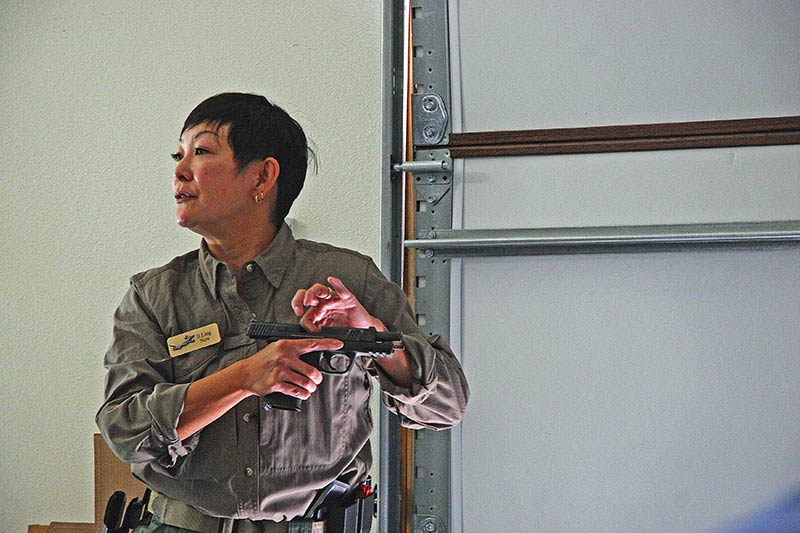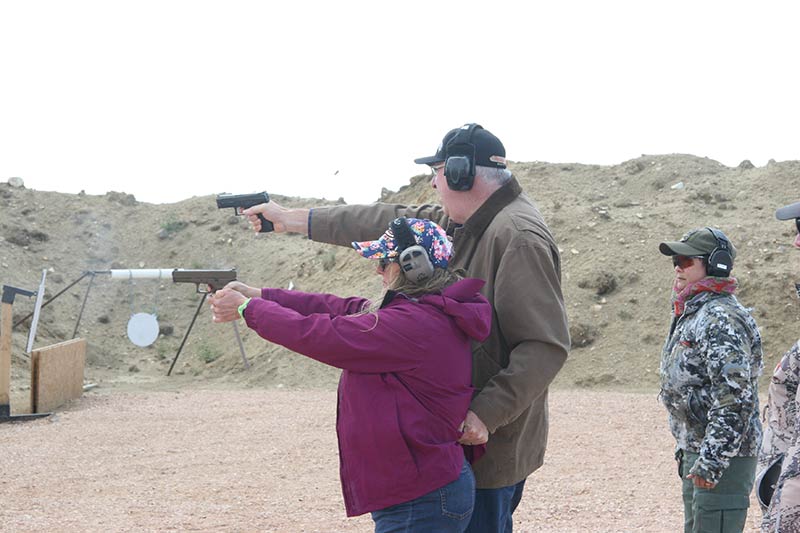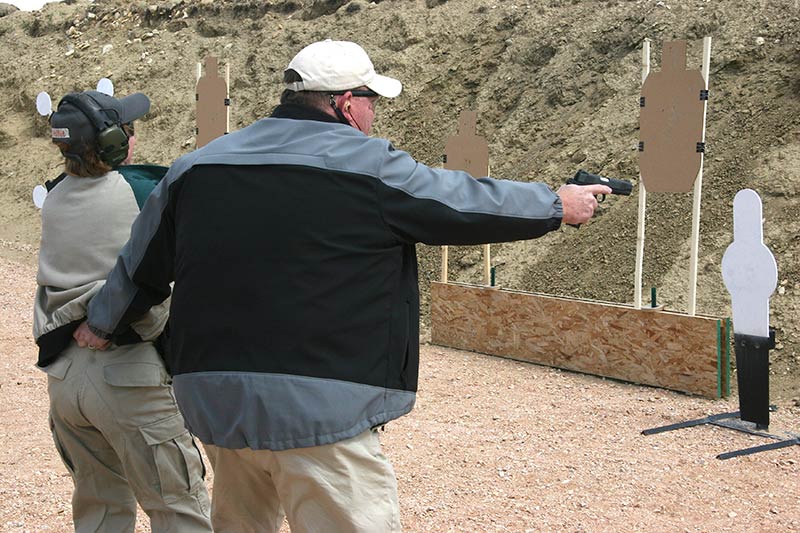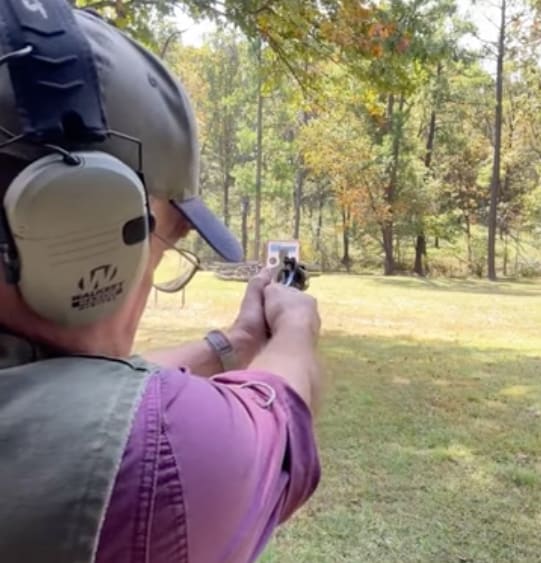Exclusive: A Couple's Course on Defensive Shooting Team Tactics
A brief browsing of the internet for firearms training will quickly confirm that there are bizarre trainers teaching bizarre tactics out there these days. When we are talking about spending your hard-earned cash on something, and something as important as training that could save your life, you must exercise some prudence in your selection.
One refreshing exception to all that questionable training is Il Ling New, one of Gunsite’s most popular instructors. She may be a woman that is small in stature, but she is large in command presence. My wife had taken the Gunsite Lady’s Class from Il Ling and experienced amazing growth in her skills and enthusiasm about shooting. So, my wife and I jumped at the chance to take a couple’s class focused on team tactics with her.
Since most of the participants had little or no formal training, Il Ling started by giving each class member a ballpoint pen. “Hold the pen with the plunger touching the middle of the top pad of your trigger finger,” she instructed. “Now, as I count, slowly add pressure to the plunger until the pen clicks. One pound, two pounds, three pounds, four pounds … ” until a unanimous “click” was heard. “That’s how you should press the trigger on your handgun,” she said.
In the fifty years that I’ve been a pistol shooter, I’ve never experienced a more effective introduction to trigger manipulation. In less time than I anticipated, Il Ling had the entire class conducting failure drills on the range (two to the body, one to the head), stoppage drills and shooting with movement to a level that exceeded everyone’s prior experience. We were now ready for the “team tactics” portion of the training.
Where It Counts
“Realizing that bad things CAN happen to you is the first step in not getting behind the curve,” she stated to set the mood for the team tactics portion of the program. “You and your partner have to answer three questions beforehand: Are we going to escape? Are we going to hide? Are we going to fight?”
According to Il Ling, one of the very first actions that couples should take is to make a written list of each other’s strengths. Each person contributes something to the team, but those contributions need to be identified, discussed and compared to their partner’s contributions. This entails more than just skill-sets. Knowing who is the better shooter, the better communicator and the better decision-maker under stress is vital. Personality and physical traits also need to be considered. Who is more mobile? Who looks the most threatening or the most like a victim? Who is the best actor, can feign fear and best provide a distraction? Such issues need to be identified and discussed.
Il Ling stressed that awareness provides time to prepare for danger, and therein lies the reason to know and understand the mindset color code taught by almost every reputable trainer. When at home, however, complacency of mindset is common, hence anything that can enhance awareness is good. Having a dog is the best alarm system available. Noise, not ferocity, is the key and a dachshund is as good as a Rottweiler at providing awareness.
She suggests hanging bells or wind chimes on the doors to provide an audible alert without creating a “defensive bunker” look to your interior. Security film can be used to virtually increase the tensile strength of accent windows on or around doors. They can still be compromised, but it will take time, effort and noise to break through, giving you awareness and time to prepare. Unless you have loved ones in adjacent bedrooms, lock your bedroom door. Interior doors are comparatively easy to breech, but doing so will result in noise giving you added awareness and time to prepare.
According to Il Ling, surviving a home invasion will quite likely depend upon certain elements that need to be equipped and practiced:
- All partners need to know the longest open distance in the house and the distance between the bedroom door and the far side of the bed. Both partners need to practice shooting at those distances.
- Cell phones and flashlights need to be staged on both sides of the bed and it needs to be predetermined who is assigned to sweep the room with light while the other calls 911.
- Each partner needs to know where and in what condition their partner’s gun is stored and needs to practice shooting that gun as well as their own.
- Unless you have children or loved ones that need to be rescued from other rooms, stay put. Don’t go searching for intruders.
- Each partner should have a sector or an area of responsibility. In the military it’s known as a “field of fire.” Cross-firing is potentially hazardous, especially if you and your partner are forced to move and simultaneously shoot.
According to Il Ling, when in public a couple needs to be aware that perpetrators will usually target the male prior to the female. That means that although the woman is an equal partner in the defense of the team, she may in fact play the more critical role. Both members of the couple need to be armed and, just like at home, each needs to know where and in what condition their partner’s gun is being carried. Il Ling is not a proponent of off-body carry such as women carrying in a purse. “I was told by a Gunsite instructor that if a man accosts a woman he wants one of two things from her … one of those is her purse,” she told the class. In that case a snatched purse has just made the world a little more dangerous.
The information was provided not as dogma but as suggestions to be considered with each individual couple deciding which is right for them. For example, if one of the partners is taken hostage, Il Ling suggests that you not let them be taken out of your sight. This requires a “shoot/don’t shoot” decision. Each individual has to determine for themselves whether they’re capable of making such a shot.
Communication is the key to effective team tactics and she recommends that every couple have code words for the following:
- “Look out,” “danger,” “watch the perimeter”
- “I’m not safe but am being forced to say that I am”
- “Drop down so I can shoot”
- “I’m going to shoot”
Range Time
On the range, it became clear that shooting, communicating and moving in concert with a partner is not intuitive. Up to this point in the class, all shooting had been conducted by individual shooters engaging individual targets. Now, couples were assigned to engage multiple targets which meant that they had to determine which targets they were individually responsible for. Each couple determined their own code words to inform their partner that they were reloading and needed to be covered, a response word to tell their partner that they would cover them, and a final word to let the partner know that they were back in the fight. Yelling, “reloading,” “covering,” “ready,” “check,” in the midst of engaging multiple targets with a partner is not the simple exercise that it seems.
Finally, moving as a team was addressed. Maintaining physical contact for safety and to provide a united defense was accomplished by one shooter grabbing their partner by the back of their belt and initiating the movement. “Big step, little step, big step, little step,” Il Ling yelled as the couples practiced shuffle-stepping laterally across the firing line. While this “two-step” lacked cotillion precision, couples eventually stopped stepping on their partners feet and the element of shooting was added to the exercise. The shooter holding on to their partner shot one handed while the other shot with both hands. Focusing on foot placement and muzzle awareness, while simultaneously shooting and communicating, combined to make it a challenging experience.
As the class progressed, it became obvious that “teaming” with a partner would only become an effective force multiplier with well-practiced collaborative effort. There is nothing instinctive or natural about team tactics and without coordinated activity, “The whole is less than the sum of its parts,” to misquote Aristotle.
By the end of the third day no one felt ready to enter a synchronized shooting contest, however there was a heightened ability to shoot, move and communicate and many of the wives were outshooting their husbands. Many of the men in class realized their wives were better shooters than they imagined.
Mastering team tactics far exceeds learning to shoot. One can learn sight alignment from a book, but not trigger control. It takes hands-on practice to master the “feel” of the trigger. The same is true of mastering the art of working as a team. That hands-on practice is best conducted under the guidance of a professional. In addition to Il Ling, there are a number of professional resources that can provide that guidance such as Gunsite and Thunder Ranch. However, a class like Il Ling’s is a good first step to awareness and awareness is the first step to action.
For more information, contact Il Ling New at: [email protected]
Subscribe To American Handgunner

Get More Personal Defense Tips!
Sign up for the Personal Defense newsletter here:








